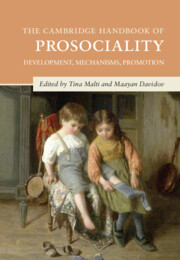Book contents
- The Cambridge Handbook of Prosociality
- Cambridge Handbooks in Psychology
- The Cambridge Handbook of Prosociality
- Copyright page
- Dedication
- Contents
- Figures
- Contributors
- Part I Development of Prosociality
- 1 Introduction: What Is Prosocial Development?
- 2 Developmental Theories of Prosociality
- 3 The Role of Genetics in the Development of Prosocial Behavior
- 4 Neurobiology of Prosociality
- 5 The Developmental Psychophysiology of Prosociality
- 6 The Origins of Prosociality from a Developmental and Comparative Perspective
- 7 Prosocial Behavior in Infancy and Early Childhood
- 8 Prosociality in Middle Childhood
- 9 Prosocial Behaviors in Adolescence
- 10 Prosocial Development across the Lifespan
- Part II Antecedents and Mechanisms of Prosociality
- Part III Development of Prosociality in Context
- Part IV Applications
- Index
- References
10 - Prosocial Development across the Lifespan
from Part I - Development of Prosociality
Published online by Cambridge University Press: 25 May 2023
- The Cambridge Handbook of Prosociality
- Cambridge Handbooks in Psychology
- The Cambridge Handbook of Prosociality
- Copyright page
- Dedication
- Contents
- Figures
- Contributors
- Part I Development of Prosociality
- 1 Introduction: What Is Prosocial Development?
- 2 Developmental Theories of Prosociality
- 3 The Role of Genetics in the Development of Prosocial Behavior
- 4 Neurobiology of Prosociality
- 5 The Developmental Psychophysiology of Prosociality
- 6 The Origins of Prosociality from a Developmental and Comparative Perspective
- 7 Prosocial Behavior in Infancy and Early Childhood
- 8 Prosociality in Middle Childhood
- 9 Prosocial Behaviors in Adolescence
- 10 Prosocial Development across the Lifespan
- Part II Antecedents and Mechanisms of Prosociality
- Part III Development of Prosociality in Context
- Part IV Applications
- Index
- References
Summary
In this chapter, we review existing literature on the development of prosociality throughout the lifespan by highlighting the different factors/motives underlying individuals’ prosocial actions and their beneficial effects across time. First, we define the concept of prosociality and discuss the main theoretical issues related to its study from a lifespan perspective. Next, we review key empirical findings on prosociality by considering three main developmental phases (infancy and childhood, adolescence and young adulthood, adulthood and older adults) and we underline how an analysis of the main motives/factors operating in each phase can help explain the variability in prosocial development. Based on our review, we also offer some guidelines for the design of intervention actions that are developmentally appropriate and meaningful for the targeted age groups. Finally, we conclude by identifying potential gaps in the literature and we indicate promising directions for future studies.
- Type
- Chapter
- Information
- The Cambridge Handbook of ProsocialityDevelopment, Mechanisms, Promotion, pp. 189 - 206Publisher: Cambridge University PressPrint publication year: 2023
References
- 1
- Cited by



